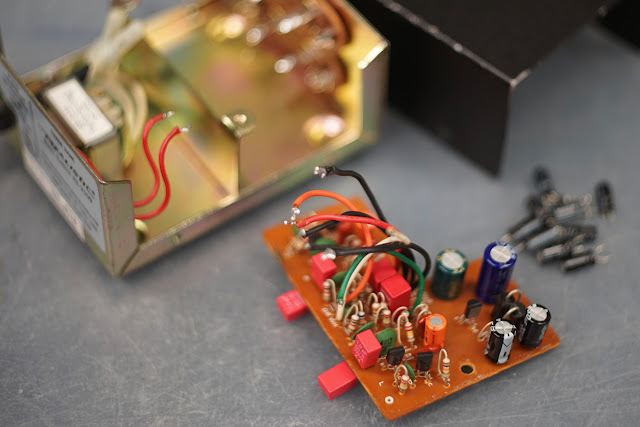Even if I was a Radio Shack devotee in the early 80s, I didn't pay much attention to this RIAA phono preamp because it didn't have high-end audio pretensions. As the saying goes, ignorance is bliss.😆
 |
| scanned from page 36 of the 1989 catalog |
This unit was first introduced in the 1980 catalog (p. 22) as part number 42-2101 at $19.95, then as part number 42-2109 for $24.95 in 1989, and made its final appearance for $27.95 on page 103 of the 1992 catalog.
 |
| Realistic MKVII idler-driven turntable, a future feature😊 |
With the resurgence of interest in LP playback, it was rediscovered by aficionados and has developed quite a following. No ICs or op-amps are to be found inside. It's a simple discrete circuit, which minimizes signal processing.
!!!WARNING!!!
The voltages in this circuit are potentially lethal! Proceed at your own risk!
The circuit is a basic two stage cascade + a negative feedback RIAA EQ looped from the output back to the input. It is very similar in topology to its tube forebears - the Shure M65 and the phono section of the Dyna PAS.
Typically, I don’t subscribe to a wholesale approach of replacing caps but this is a very simple circuit that was built at a certain price point. Since I had some decent quality parts surplus from my CD player and DAC modification projects, I replaced the electrolytic capacitors in the signal path with film type WIMAs and increased the filter capacitance in the power supply section.
In stock form, I was already impressed by this preamp's listenability when passing through my loctal tube line stage. The parts upgrade tidied up the sound further, but it wasn’t a magical transformation.
In terms of midrange presence and transparency, low level detail, micro and macro dynamics, this preamp isn't the equal of the Shure M65 or a refreshed stock Dyna PAS phono section. Its main advantage over its vacuum tube forebears is low output impedance. This could plug into the 10k input Z of the Nobsound NS02g/JLH 1969 with no loss of frequency extremes. I won't recommend that with the M65 or PAS. There's also a slight graininess in the midrange that wasn't ameliorated by parts upgrades. That said, I don't know if one can find a "plug 'n play" phono preamp in the $100 range (or possibly more?), which will provide as much musical pleasure!















